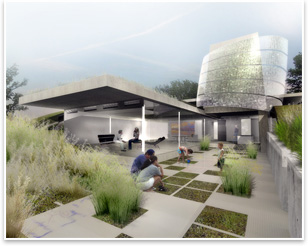
| Matthew Coates, AIA, LEED AP
Hobbies: Other than architecture? I love gardening. My wife and I are very enthused about our dog, and we do a lot of things with him. He’s a Great Dane and his name’s Henri. We do quite a bit of hiking. I [also] enjoy vintage vehicles. I have a ’67 Karmann Ghia and an old BSA motorcycle I like to putter with, but mostly we just enjoy any outdoor activity. Gardening is usually what we do these days because we’re still trying to get our landscape in order and are really enjoying learning about plants and helping them thrive. Current read: I am typically a non-fiction reader, so I’m always reading sustainable design journals and architecture books. I have a stack of books next to my bed and a stack of books next to the couch downstairs that I read in spurts. I’m not a cover-to-cover person, but I do read for a couple hours a day typically. I find that because there’s so much information out there in our industry, you have to read constantly to stay on top of things: anything from new technologies and new materials to interesting architectural developments around the world. It’s just a struggle to stay on top of it, so I’m almost always reading about architecture. It’s a form of enjoyment but also a form of research. Entering the Cradle-to-Cradle (C2C) Home competition: I worked with a team of people on the competition and primarily one other fellow, Tim Meldrum. I had always been concerned about environmental protection and the impact that architecture can have—negative or positive depending on how one approaches a project—so it was a natural draw for me to want to work on that type of a project. I was particularly attracted to it because it challenged designers to question the future of sustainability rather than current technology or what’s been done in the past and I’ve always been fascinated with the future. In fact, one of my favorite quotes is “The best way to predict the future is to invent it.” I really think that’s true. I think that the future is what we make it and I enjoyed the particular challenge of the C2C Home Competition because it asked that question.
Why spinach? They could use really any plant material that has chlorophyll in it. There were mainly two reasons why they chose spinach. First was because spinach is a dark green vegetable and it’s very densely populated with chlorophyll. The second reason is that it’s a readily available, rapidly renewable material. You could use anything, but spinach is perfect because of those two reasons. Have you used it on a built project? No, I wish. I wish it were available, but the technology is just not there. The research is ongoing, but it’s not a reality today. The technology is just in its infancy so it’s not plausible. I would say 20 years is a realistic [timeframe for manufacturing the spinach PV cell] because one of the problems they’re having with the spinach technology is finding a way to stabilize it and make it productive over a longer period of time. I think that’s their biggest challenge. Then, also they need to have it be productive under different climactic conditions, so they need to have the time and funding for their research to be able to solve those problems and to make it more efficient as well.
Do you incorporate C2C ideals in your architecture? Yes, as much as possible. In my own architecture practice, we always try to get that far with our clients. What I’ve learned is that clients are never completely ignorant of sustainable design and they’re never completely aware of everything that’s out there. They’re always somewhere in between. Our goal is to provide as much information and as many options to them so that we can take them as far as they’re comfortable going—and maybe even a little further by challenging some of their thoughts and concerns, not to the point of disrespect, but to where they’re willing to go based on the relationship we have and their concern for the environment. We definitely try to use Cradle-to-Cradle philosophy in what we’re doing every chance we get. And that’s why I do all the reading. That’s why I’m not reading fiction books and why I’m reading journals and periodicals and things that focus on the latest opportunities to do that. |
||
Copyright 2007 The American Institute of Architects. All rights reserved. Home Page |
||
out there
down here
here to there
back to earth




